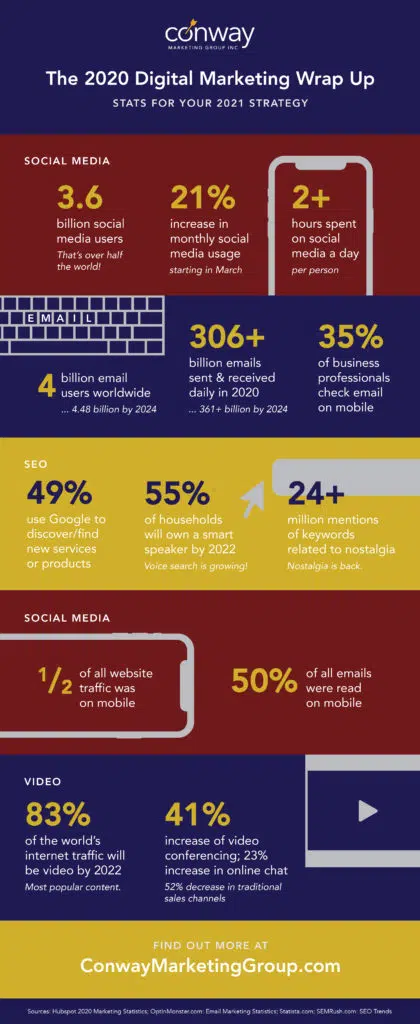Trends and stats to inform your 2021 strategy
If you’re reading this, congratulations; you have survived the chaotic year that was 2020! To say that this year was a record-setting year would be an understatement. This year was pivotal for digital marketing and forced the industry into a new landscape that we are all just beginning to navigate.
Here is Conway Marketing Group’s 2020 Wrap Up, covering our biggest takeaways and stats to carry with you into 2021.
Social Media: Everyone spent A LOT of time scrolling
The COVID-19 pandemic took up a lot of the collective headspace. It has been mentioned 1.2B times to date. With most countries quarantining and shifting to remote-work lifestyles, global social media consumption skyrocketed. Since March, there has been a 21% uptick in monthly social media usage.
This year, 3.6 billion people (over half of the world) were active on social media. The average person spent over 2 hours scrolling on Instagram, Facebook, Linkedin, Twitter, TikTok, and Youtube.
If your business has been waiting for a sign to launch a social media strategy, this is it. The largest actively engaged audience in history is on social media, and successful B2B and B2C brands can take advantage of this by creating and promoting authentic, useful and compelling content.
Email: It’s bigger than ever
The number of email users worldwide is now over 4 billion. This number will extend to 4.48 billion by 2024.
Email is one of the oldest digital marketing strategies, and it further solidified its importance this year as many began to work from home, severely limiting face-to-face conversations and in-person events. People sent and received roughly 306.4 billion daily emails this year; a number predicted to grow to over 361 billion by 2024.
Consumers have indicated that they still prefer emails and are willing to engage – if it’s good content. Instead of focusing on email quantity, B2B brands should be crafting high-value, personalized emails that establish domain expertise.
SEO: You can now speak it into existence
It’s no secret that a robust SEO strategy can be a differentiator for a business. 49% of users say they Google to discover or find a new service or product. However, voice-activated searches will be entering the scene in a big way.
55% of households will own a smart speaker such as Google Home, Amazon Echo, and Sonos One by 2022. We are increasingly using smart speakers and smartphone assistants like Apple’s Siri to conduct what would have previously been a Google search.
To accommodate this trend, optimize your SEO strategy with longer, more natural form keyword phrasing to match how users interact with and speak to these devices. For example, when searching for local garden shops, a search-engine user might type “garden shops near me,” but a voice search would sound like, “Where can I find plants in Los Angeles?”
Speaking of local, let’s talk about local SEO’s glory moment this year. Over two years, there was a 150%+ growth in mobile searches for “____ near me.” As the internet’s reach broadens, consumers are using it to stay local.
Nobody is putting down their mobile phones
It’s official. Mobile devices generated about half of all website traffic globally, and your digital strategy needs to lead with this in mind.
50% of all read emails were through a mobile device. This statistic affirms the chance B2B brands have to reach their clients on the go, a much bigger window of opportunity than from a work desktop.
To further force our hands, Google rolled out mobile-first indexing. This means the search engine will prioritize a website’s mobile version as the primary version over desktop. Having a mobile-friendly platform will give you the upper hand with indexing and ranking.
Video content is king
This year rattled the B2B industry’s comfort zone as companies shifted their go-to-market from traditional meetings (a 52% decrease this year) to video and live chat platforms. Videoconferencing grew 41%, with online chat up +23% with it. This landscape doesn’t seem temporary; many consumers have expressed a preference for video chats and demos as a starting point.
Video has been the rising star in the content marketing world for some time now. It’s not the most commonly used marketing content, with most social media platforms being video-heavy.
By 2022, 83% of the world’s internet traffic will be video. Let’s start recording!
The gist? We’re optimistic about the future of digital.
This puzzling year has challenged everything experts thought they knew about digital marketing. It has been a catalyst for reinvention and true innovation as brands create new blueprints for resiliency with content that connects.
2020 was a big learning moment, and it has set the stage for some fresh and unprecedented strategies in 2021. We’d love to talk to you about your 2021 strategy and see how we can help! For more information and a high-level marketing strategy assessment, contact us today.




